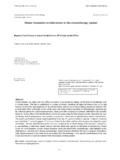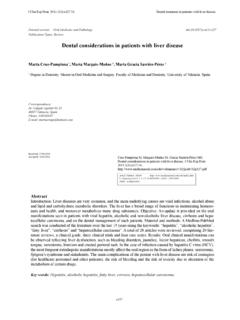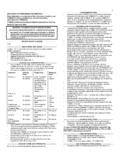Transcription of Prevalence of Herpes Simplex Virus Type 1 and Type 2 in ...
1 NCHS Data Brief No. 304 February 2018. Prevalence of Herpes Simplex Virus Type 1 and Type 2 in Persons Aged 14 49: United States, 2015 2016. Geraldine McQuillan, , Deanna Kruszon-Moran, , Elaine W. Flagg, , , and Ryne Paulose-Ram, , Herpes Simplex Virus types 1 and 2 (HSV-1 and HSV-2) are common, lifelong Key findings infections, which often have no symptoms (1). People with symptoms may Data from the National have painful blisters or sores at the site of infection (2,3). The viruses are Health and Nutrition transmitted through contact with an infected person's lesion, mucosal surface, Examination Survey or genital or oral secretions. This report provides recent national estimates of HSV-1 and HSV-2 antibody Prevalence from the 2015 2016 National Health During 2015 2016, and Nutrition Examination Survey (NHANES) among persons aged 14 49 by Prevalence of Herpes Simplex Virus type 1 (HSV-1) was age, sex, and race and Hispanic origin, and examines trends in Prevalence by , and Prevalence of race and Hispanic origin from 1999 2000 to 2015 2016.
2 Herpes Simplex Virus type 2 Keywords: HSV-1 HSV-2 NHANES. (HSV-2) was Prevalence of both HSV-1 Prevalence of HSV-1 during 2015 2016 was highest among and HSV-2 increased with age. Mexican-American persons and lowest among non-Hispanic Prevalence of both HSV-1 white persons. and HSV-2 was higher among females than males. Figure 1. Age-adjusted Prevalence of Herpes Simplex Virus type 1 among persons aged 14 49, by age group, sex, and race and Hispanic origin: United States, 2015 2016. Prevalence of HSV-1 was highest among Mexican- Total population unadjusted American persons and lowest Total population age adjusted among non-Hispanic white persons. HSV-2 Prevalence was 14 191 years 20 29 years highest among non-Hispanic 30 39 years black persons and lowest 40 49 years among non-Hispanic Asian Male 2. persons. Female Prevalence of both HSV-1 Non-Hispanic white3 and HSV-2 decreased from Non-Hispanic black3,4 Mexican-American4. 1999 2000 to 2015 2016 (from Non-Hispanic Asian3,4 to , and from to , respectively).
3 0 10 20 30 40 50 60 70 80. Percent 1. Linear increase with age group. 2. Significantly lower than females. 3. Significantly lower than Mexican-American persons. 4. Significantly higher than non-Hispanic white persons. NOTES: Age adjusted by the direct method to the 2000 Census population, using age groups 14 19, 20 29, 30 39, and 40 49 years. Total population includes all race and Hispanic-origin groups including those not shown separately. Access data table for Figure 1 at: #1. SOURCE: NCHS, National Health and Nutrition Examination Survey, 2015 2016. DEPARTMENT OF HEALTH AND HUMAN SERVICES. Centers for Disease Control and Prevention National Center for Health Statistics NCHS Data Brief No. 304 February 2018. The Prevalence of HSV-1 among persons aged 14 49 was ( when adjusted for age) (Figure 1). Prevalence increased linearly with age, from among those aged 14 19, to , , and among those aged 20 29, 30 39, and 40 49, respectively.
4 Age-adjusted Prevalence was higher among females ( ) than males ( ). Age-adjusted Prevalence was highest among Mexican-American persons ( ) and lowest among non-Hispanic white persons ( ). There was no significant difference in Prevalence between non-Hispanic black ( ) and non-Hispanic Asian ( ) persons. Prevalence of HSV-1 decreased over time from 1999 2000 to 2015 2016. Age-adjusted Prevalence of HSV-1 decreased linearly over time by percentage points, from % in 1999 2000 to in 2015 2016 (Figure 2). Age-adjusted Prevalence of HSV-1 decreased linearly from 1999 2000 to 2015 2016 for all race and Hispanic-origin subgroups: from to for non-Hispanic white, to for non-Hispanic black, and to for Mexican-American persons. Figure 2. Trends in age-adjusted Prevalence of Herpes Simplex Virus type 1 among persons aged 14 49, for the total population and by race and Hispanic origin: United States, 1999 2000 through 2015 2016. 100. Mexican-American1.
5 80. Non-Hispanic black1. Total population1. 60. Percent Non-Hispanic white1. 40. 20. 0. 1999 2001 2003 2005 2007 2009 2011 2013 2015 . 2000 2002 2004 2006 2008 2010 2012 2014 2016. 1. Significant decreasing linear trend over time, p < NOTES: Age adjusted by the direct method to the 2000 Census population, using age groups 14 19, 20 29, 30 39, and 40 49 years. Total population includes all race and Hispanic-origin groups including those not shown separately. Data for the Asian subpopulation are only available since 2011, so this subpopulation is not shown separately, but included in the total population. Access data table for Figure 2 at: #2. SOURCE: NCHS, National Health and Nutrition Examination Survey, 1999 2016. 2 . NCHS Data Brief No. 304 February 2018. Prevalence of HSV-2 during 2015 2016 was highest among non-Hispanic black persons and lowest among non-Hispanic Asian persons. The Prevalence of HSV-2 among persons aged 14 49 was ( when adjusted for age) (Figure 3).
6 Prevalence increased linearly with age, from among persons aged 14 19, to , , and among those aged 20 29, 30 39, and 40 49, respectively. Age-adjusted Prevalence was higher among females ( ) than males ( ). Age-adjusted Prevalence was highest among non-Hispanic black persons ( ) and lowest among non-Hispanic Asian persons ( ). There was no significant difference in Prevalence between non-Hispanic white ( ) and Mexican-American ( ) persons. Figure 3. Age-adjusted Prevalence of Herpes Simplex Virus type 2 among persons aged 14 49, by age group, sex, and race and Hispanic origin: United States, 2015 2016. Total population unadjusted Total population age adjusted 14 191 years 20 29 years 30 39 years 40 49 years Male2 Female Non-Hispanic white3,4 Non-Hispanic black4 Mexican-American3,4 Non-Hispanic Asian3 0 10 20 30 40. Percent 1. Linear increase with age group. 2. Significantly lower than females. 3. Significantly lower than non-Hispanic black persons.
7 4. Significantly higher than non-Hispanic Asian persons. NOTES: Age adjusted by the direct method to the 2000 Census population, using age groups 14 19, 20 29, 30 39, and 40 49 years. Total population includes all race and Hispanic-origin groups including those not shown separately. Access data table for Figure 3 at: #3. SOURCE: NCHS, National Health and Nutrition Examination Survey, 2015 2016. 3 . NCHS Data Brief No. 304 February 2018. Prevalence of HSV-2 decreased over time from 1999 2000 to 2015 2016. Age-adjusted Prevalence of HSV-2 decreased linearly over time by percentage points, from in 1999 2000 to in 2015 2016 (Figure 4). Age-adjusted Prevalence of HSV-2 decreased linearly from 1999 2000 to 2015 2016 for all race and Hispanic-origin subgroups: to for non-Hispanic white, to for non-Hispanic black, and to for Mexican-American persons. Figure 4. Trends in age-adjusted Prevalence of Herpes Simplex Virus type 2 among persons aged 14 49, for the total population and by race and Hispanic origin: United States, 1999 2000 through 2015 2016.
8 50. Non-Hispanic black1. 40. 30. Percent 20 Total population1. 10 Mexican-American1 Non-Hispanic white1. 0. 1999 2001 2003 2005 2007 2009 2011 2013 2015 . 2000 2002 2004 2006 2008 2010 2012 2014 2016. 1. Significant decreasing linear trend over time, p < NOTES: Age adjusted by the direct method to the 2000 Census population, using age groups 14 19, 20 29, 30 39, and 40 49 years. Total population includes all race and Hispanic-origin groups including those not shown separately. Data for the Asian subpopulation are only available since 2011, so this subpopulation is not shown separately, but included in the total population. Access data table for Figure 4 at: #4. SOURCE: NCHS, National Health and Nutrition Examination Survey, 1999 2016. 4 . NCHS Data Brief No. 304 February 2018. Summary During 2015 2016, the Prevalence of HSV-1 was and of HSV-2 was among those aged 14 49. Prevalence of both viruses was higher among females than males and increased linearly with age.
9 Differences by race and Hispanic origin were different for the two viruses, with Mexican-American persons having the highest Prevalence of HSV-1 ( ) and non-Hispanic black persons having the highest Prevalence of HSV-2 ( ). Differences by race and Hispanic origin, and the increasing Prevalence with increasing age for both HSV-1 and HSV-2, have been reported previously (4,5). The higher Prevalence of HSV-2 among females has also been reported (6). From 1999 through 2016, there was a significant decline in the age-standardized Prevalence of HSV-1 and HSV-2. For both Virus types, a decrease in Prevalence over time was seen in all race and Hispanic-origin subpopulations. Decreasing HSV-1 Prevalence has been reported previously (4 7). A nonsignificant decline in overall Prevalence of HSV-2 from 1999 through 2010 was reported in a previous study (5). This report provides the latest estimates of HSV-1 and HSV-2 Prevalence in the United States.
10 NHANES does not include populations that may be at higher risk for acquiring HSV-2 ( , those incarcerated and the homeless). Therefore, these data may provide conservative estimates of both HSV-1 and HSV-2 in the population aged 14 49. Definitions HSV-1: Prevalence of antibody to Herpes Simplex Virus type 1 from tested sera. HSV-2: Prevalence of antibody to Herpes Simplex Virus type 2 from tested sera. 5 . NCHS Data Brief No. 304 February 2018. Data source and methods Data for this report are from NHANES, a cross-sectional survey that uses a complex, multistage, probability design to select a sample of the civilian noninstitutionalized population. It consists of interviews in participants' homes, followed by standardized physical examinations that include collection of various biological specimens. In 1999 2016, sera for HSV-1 and HSV-2. antibody testing were available for persons aged 14 49 (see: nhanes/2013-2014/ ). In 2011 2016, non-Hispanic black, non-Hispanic Asian, and Hispanic persons, including Mexican American-persons, were oversampled.














